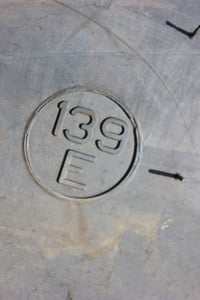Trailer tyres are pushed to their limit during a harvest – they go from being fully loaded to empty in the space of a few hours, they switch from fields to roads several times a day, and farmers typically prefer to increase the load rather than make an extra trip.
But just how far can you push them? How much can your trailer tyres bear, and what can you do to prevent problems at a time when everything has to be done as quickly as possible to save time?

During harvest time, transportation is already considered as the black mark slowing down your harvester's capacity, so just imagine the effect of a punctured trailer tyre due to overloading, an undetected weakness or the intensive use of a tyre that's too old.
 The load index is written on your tyres in the form of a number, usually between 100 and 200, corresponding to the acceptable load for the tyre at a given pressure.
The load index is written on your tyres in the form of a number, usually between 100 and 200, corresponding to the acceptable load for the tyre at a given pressure.
The speed index is a letter that corresponds to the usage speed of the tyre. You will need to calculate these indices to make sure you choose the most suitable tyres for your intended use.
To do this, refer to the load and speed index tables provided by the manufacturer.
| I.C. | kg | I.C. | kg | I.C. | kg | I.C. | kg | I.C. | kg |
| 60 | 250 | 61 | 257 | 62 | 265 | 63 | 272 | 64 | 280 |
| 65 | 290 | 66 | 300 | 67 | 307 | 68 | 315 | 69 | 325 |
| 70 | 335 | 71 | 345 | 72 | 355 | 73 | 365 | 74 | 375 |
| 75 | 387 | 76 | 400 | 77 | 412 | 78 | 425 | 79 | 437 |
| 80 | 450 | 81 | 462 | 82 | 475 | 83 | 487 | 84 | 500 |
| 85 | 515 | 86 | 530 | 87 | 545 | 88 | 560 | 89 | 580 |
| 90 | 600 | 91 | 615 | 92 | 630 | 93 | 650 | 94 | 670 |
| 95 | 690 | 96 | 710 | 97 | 730 | 98 | 750 | 99 | 775 |
| 100 | 800 | 101 | 825 | 102 | 850 | 103 | 875 | 104 | 900 |
| 105 | 925 | 106 | 950 | 107 | 975 | 108 | 1,000 | 109 | 1,030 |
| 110 | 1,060 | 111 | 1,090 | 112 | 1,120 | 113 | 1,150 | 114 | 1,180 |
| 115 | 1215 | 116 | 1,250 | 117 | 1,285 | 118 | 1,320 | 119 | 1,360 |
| 120 | 1,400 | 121 | 1,450 | 122 | 1,500 | 123 | 1,550 | 124 | 1,600 |
| 125 | 1,650 | 126 | 1,700 | 127 | 1,750 | 128 | 1,800 | 129 | 1,850 |
| 130 | 1,900 | 131 | 1,950 | 132 | 2,000 | 133 | 2,060 | 134 | 2,120 |
| 135 | 2,180 | 136 | 2,240 | 137 | 2,300 | 138 | 2,360 | 139 | 2,430 |
| 140 | 2,500 | 141 | 2,575 | 142 | 2,650 | 143 | 2,725 | 144 | 2,800 |
| 145 | 2,900 | 146 | 3,000 | 147 | 3,075 | 148 | 3,150 | 149 | 3,250 |
| 150 | 3,350 | 151 | 3,450 | 152 | 3,550 | 153 | 3,650 | 154 | 3,750 |
| 155 | 3,875 | 156 | 4,000 | 157 | 4,125 | 158 | 4,250 | 159 | 4,375 |
| 160 | 4,500 | 161 | 4,625 | 162 | 4,750 | 163 | 4,875 | 164 | 5,000 |
| 165 | 5,150 | 166 | 5,300 | 167 | 5,450 | 168 | 5,600 | 169 | 5,800 |
| 170 | 6,000 | 171 | 6,150 | 172 | 6,300 | 173 | 6,500 | 174 | 6,700 |
| 175 | 6,900 | 176 | 7,100 | 177 | 7,300 | 178 | 7,500 | 179 | 7,750 |
| 180 | 8,000 | 181 | 8,250 | 182 | 8,500 | 183 | 8,750 | 184 | 9,000 |
| 185 | 9,250 | 186 | 9,500 | 187 | 9,750 | 188 | 10,000 | 189 | 10,300 |
| SPEED CODE | SPEED (km/h) | SPEED CODE | SPEED (km/h) | |
| A1 | 5 | B | 50 | |
| A2 | 10 | C | 60 | |
| A3 | 15 | D | 65 | |
| A4 | 20 | E | 70 | |
| A5 | 25 | F | 80 | |
| A6 | 30 | G | 90 | |
| A7 | 35 | |||
| A8 | 40 |
The speed code is the potential speed for a load matching the load index, under the usage conditions specified by the manufacturer.
In all cases, for optimal use of your tyres remember to adapt the pressure in accordance with the manufacturer's data, and check it regularly.
Your tyres are capable of withstanding high speeds, provided you have respected the corresponding load (see table above), and some trailers are approved for high speeds. However, the regulations stipulate a maximum speed for tractors alone, which is very different to the speed for a hitched vehicle.
The authorised speed limit for a tractor with trailer is only 25 km/h, regardless of whether or not the trailer is loaded.
The permissible gross weight on your tractor's registration document tells you the total authorised weight when coupled (weight of the tractor + trailer + load).
The loading point of reference for semi-mounted trailers is limited to 16 tonnes for single axle, 29 tonnes for twin axle and 32 tonnes for triple axle.
Single-axle trailers are only permitted a load of 16 t, which is reached when the trailer is loaded normally. For high-power 200 hp tractors with a triple-axle trailer, it is very easy to exceed the authorised limit of 40 tonnes on the road. And don't forget, the fine for overloading your trailer can be as much as €1500.
To reduce the impact of driving your trailers on your land, choose wide low-pressure tyres.
The width of the tyre helps distribute heavy loads, and the large volume of air contained in the tyre enables you to increase the permissible load without increasing the pressure.
Since the pressure exerted on the ground is correlated with the tyre pressure, a low pressure will limit compaction, even with a trailer full of harvested grain.
To learn more and boost your farm's profits, Bridgestone Agriculture is offering you a free, detailed eBook that explains the essential role your agricultural tyres play in your productivity.
The most people who have read this article have also read the following articles, which are listed below in order of popularity:
This information is intended only to make you aware of the technical and functional aspects of agricultural tires and their use. It does not allow you to make a judgment or a definitive conclusion on a given problem. Only your agricultural tire expert is able to make a technical assessment and take a final decision, case by case.

BRIDGESTONE EUROPE NV/SA
AG Department
Leonardo Da Vincilaan 1
1930 Zaventem | Belgium
Our regional office:
Athena Drive, Tachbrook Park
Warwick CV34 6UX
United Kingdom